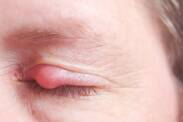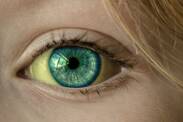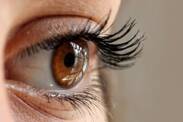Symptoms associated with the eyes

Increased watery eye
Increased tearing is one of the common reasons for visiting the eye doctor. It can be caused by many eye problems, but there can be more reasons.

Purulent discharge from the eye
Purulent discharge from the eye is the main sign of inflammation of the eye. What is its cause and can it be caused by drafts? Can it be treated at home and with the help of herbs or other grandmotherly advice?

Eye irritation
Do you have irritated eyes after working behind a monitor all day, or is it caused by draughts? What other causes can we encounter?

Bulk on the cap
Bulges on the eyelids occur as a result of increased exertion, improper hygiene, when fat metabolism is disturbed, and as a result of infection. Inflammation of the blocked sebaceous gland is common. The most common diseases are barley and wolf'sbane. However, a bulge can also be of tumor origin.

Cutting the eye
Cutting in the eye is one of the symptoms of eye inflammation or infection. But it also occurs with fatigue or dry eye syndrome. The external environment, namely dusty, dry and warm or windy weather, also has a big influence. Another cause of cutting in the eye can be allergies.

Yellow whites of the eyes
The whites of the eyes are normally white in colour. In the case of disease, they may be yellow. This is also the case, for example, in liver failure. Gallstones are another example. The condition is worse in the case of malignant disease. They can be seen even in newborns.

Deterioration of vision
Visual impairment can be congenital, acquired, permanent, or temporary. It can be caused by old age, degenerative diseases, and inflammation. Visual impairment is also a symptom of diseases outside the eyes.

Redness of the eyelid
Redness of the eyelids can have various causes, of which we think primarily of inflammation or irritation. Microbes and external factors such as dust, smoke or cold are the main causes. There are also other possibilities.

Blurred vision
Blurred or foggy vision is a typical sign of cataracts, but it's not the only cause. There are more.

Redness of the conjunctivae
Redness of the conjunctiva is typical of inflammatory diseases, but can it occur for other reasons?

Bulging eyes
Bulging eyes (exophthalmos) are usually a symptom of a problematic thyroid gland. However, there may be more than one cause. Moreover, they are not just a cosmetic problem; vision can also be compromised.

Loss of field of vision
Visual field loss is the loss of visual acuity or complete loss of perception in the visible area around a person. The cause may be based in the eye, the optic nerve or directly in the brain and visual centre.

Pressure in the eye
It is caused by a disease of the eye, but also of the eyelid. It can be a symptom of inflammation, but sometimes a tumor or other serious disease is behind the pressure. An eye examination is the best option when difficulties occur.

Sensitivity to light
Sensitivity to light is a sign of eye disease. Symptoms such as eye pain, scratching, itching or eye fatigue are also associated. In other cases, it may indicate a neurological problem, such as meningitis.

Double vision
Double vision is a sign of a vision problem. But it's not always due to impaired vision and squinting.

Eye Pain
Pain is a sign that something is wrong. It is really irreplaceable despite the fact that it is unpleasant. Pain in one eye or in both eyes, pain in the eyelids, or pain around the eye needs to be properly examined. Neglecting this symptom can leave consequences.
The eyes are a sensory organ that responds to light, and the human eye is one of the most complex organs. It provides vision and is fully adaptable to focus a beam of light on the retina. Thanks to the eyes, we can see our surroundings and can receive visual sensations from the environment, which are transferred from the eye through the nervous system to the brain, where the visual centre processes them and the person becomes aware of what he or she sees. The eye has a rather complex structure that allows it to adapt to adverse environmental conditions.
The main part of the eye is the eyeball, which is composed of the white of the eye on the surface, the cornea, the corneal sclera, the iris, the lens, the choroid, the retina, the blind spot, and the vitreous. The space between the eyelid, the eyeball and the eye socket is lined by the conjunctiva, which is a pink-colored membrane. The lacrimal gland, which secretes tears to moisten the eye, is also located in the cavity above the eyeball. The upper and lower eyelids are used to protect the eye and the eye muscles are used to move the entire eyeball.
A beam of light is focused on the retina, and to keep the beam well focused on the retina, both the cornea and the lens focus multiple light signals to a single point on the retina where these light signals come together. The light then causes chemical changes in the light-sensitive cells, which are rods and cones, and these cells send nerve signals through the optic nerves to the brain, where they are processed by the visual centre. The eye can also move at the same time, and it does so through the oculomotor muscles.
Problems within the ocular apparatus can occur virtually anywhere. Whether it is various defects around the eye on the eyelids, conjunctiva, lacrimal gland or orbicularis oculi, or directly in the eye. It can be affected by inflammation of some of its parts, problems with focusing and various refractive errors such as myopia, astigmatism or hyperopia, or the problem may be of a nervous or vascular nature. Sometimes the problem occurs directly in the visual centre in the brain.
Problems with the eyelid
The eyelids can be plagued by various inflammations, swellings or other painful or painful problems, which many times directly affect visual abilities. Often there is a lump on the eyelid, which signals inflammation of the eye gland and is typical of both lupus and barley grain on the eye. These diseases are subsequently manifested by swelling of the eyelid, but this can also occur with viral inflammation of the eyelid by herpes viruses, bacterial conjunctivitis or in some allergies or hypothyroidism.
Also, redness of the eyelid is associated with inflammation directly on or around the eyelid, for example with the aforementioned barley grain. However, redness can also be associated with dry eye syndrome, inflammation of the Meibomian gland and inflammation of the eyelid margins. The drooping and constant dropping of the eyelids is usually related to a neurological problem and occurs, for example, in Lyme disease, tuberculous meningitis and in a disease called Myasthenia gravis.
Symptoms associated with tearing
Increased tearing, or hyperlacrimation, can sometimes be observed from the eye. This is most often a manifestation of allergy, which is usually also manifested by redness of the eye and its surroundings. However, sometimes it is also a symptom of hyperthyroidism, whooping cough or adenovirus infection. Increased lacrimation can also sometimes be associated with conjunctivitis or corneal inflammation. Conversely, decreased tearing is called hypolacrimation, and if associated with burning and cutting of the eye, drying and damage to the cornea may occur.
Usually reduced tearing is caused by bacterial or viral inflammation, or occurs in Sjogren's syndrome or dry eye syndrome. If there is a purulent discharge from the eye, it is most often conjunctivitis or corneal inflammation, or it may also be from barley or lupus affecting the eyelid. Also some dangerous intraocular inflammations like iritis manifest themselves in this way. Purulent secretion from the eye is also seen in some allergies.
Deterioration of vision
Visual impairment can be a symptom of a disorder directly in the eye or it can also be a problem caused by nerve signal transmission or a problem in the brain. Visual impairment occurs, for example, in astigmatism, myopia or various opacities in the eye, but also, for example, in pituitary adenoma, diabetic retinopathy, epilepsy, cerebral haemorrhage or inadequate blood supply to the eye. Sometimes they are complete, other times there are only gaps in the field of vision.
It is the gaps in the visual field that are most associated with glaucoma, whether cataracts or glaucoma. People with epilepsy, migraine or diabetic retinopathy can also have such blackouts, or people with a condition called albinism can also have them. In epileptic seizures or optic neuritis, flashing in front of the eyes is also typical. Migraine headaches can also sometimes be associated with such conditions, but they are usually only temporary, as when they are associated with low blood pressure.
Double vision is also a relatively common problem. This can be a symptom of eye catarrh or nerve disorder, sometimes also a sign of incipient squinting. Double vision can also occur in diabetic neuropathy, migraine or stroke. Squinting, which can take several forms and is sometimes accompanied by a reduction in visual acuity, is also typical of various vision disorders. This is a typical symptom of tuberculous meningitis, toxoplasmosis or diabetic neuropathy.
The bigger vision problem is light sensitivity, or light blindness. It may be related either to a disturbance in the structure, function or innervation of the eye or, in the worse case, it is also a symptom of some more serious infectious diseases such as malaria, tick-borne encephalitis, Lyme disease or tuberculous meningitis. Also some neurological disorders or problems, such as migraine, may manifest themselves in such sensitivity. Sometimes thyroid diseases are also associated with it.
Probably the thing people fear the most is the complete loss of sight. In the case of blindness in one eye, for example, the reason may be vascular, nervous or directly in the eye due to some kind of cataract affecting only one eye. Blindness in both eyes may be caused directly in the brain by damage to the visual centre, or it may occur when nerves or blood vessels are damaged. Thus blindness can be a symptom of both diabetic retinopathy and atherosclerosis. Sometimes it is only temporary, other times permanent.
Painful and unpleasant symptoms
Irritation of the eye is very common, which can be a reaction to some form of allergy or inflammation in the eye, for example. An irritated eye is a typical symptom of conjunctivitis, but also of eyes with dioptric defects, which are more stressed and sometimes accompanied by itching, pain and fatigue. Allergies, such as dust allergy, are typically manifested in this way. Sometimes irritated eye can also be observed in dry eye syndrome, when there is insufficient moisturizing of the eye.
Itchy eye is also one of the symptoms of dry eye, which can be both a disorder of the lacrimal system and an allergic reaction, but is usually associated with redness of the eye. With inflammation, whether acute or chronic, the eye may also itch and itch, and sometimes there is a cutting sensation in the eye. Most often, itching of the eye is associated with an allergy, for example hay fever in season, which is not only manifested in the eyes, but also, for example, with a full nose.
Cutting and cutting type of pain in the eye can be caused, for example, by bacterial inflammation of the cornea, sometimes even barley grain on the eye or various other inflammatory diseases, for example, even conjunctivitis. Often, in the case of redness and itching sensation, it is also related to an allergic reaction to dust, dust mites, pollen or other external factors. Cutting of the eye is also manifested by a specific disease called trichiasis, which is characterized by improper growth of the eyelashes.
The feeling of pressure on the eye can be caused by nerve problems, sometimes a headache behind the eye, or if the pressure is coming from the outside, often barley on the eyelid is the cause. Very often pressure from the inside of the eye is a symptom of neuritis or multiple sclerosis, which are problematic diseases of the nervous system. Also, sometimes a person may have a feeling of pressure in the eye with grey or glaucoma, and this is mainly due to changes in intraocular pressure.
Other eye symptoms
Part of several infectious diseases in the body is redness of the conjunctiva of the eye. These are, for example, adenovirus infection and other infectious diseases. However, sometimes redness is also manifested in conjunctivitis or allergic reactions. Narrowed pupils of the eye are a sign of alcohol poisoning or a symptom of other intoxication, or this condition occurs during unconsciousness, and it is also a symptom of the nervous system, when there are brain disorders or lack of oxygen.
Yellow whites of the eyes instead of white are most often a sign of an increase in bilirubin in the blood, which is usually related to hepatitis infection, especially if the skin and mucous membranes are yellow. Also, in some liver diseases this symptom may be present, but this is no longer the rule. Bulging eyes, in turn, are most often a symptom of thyroid disease, whether it is hyperthyroidism or Gawes-Based disease. In any case, this symptom should not be underestimated.









